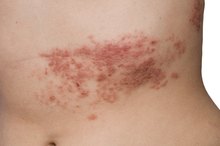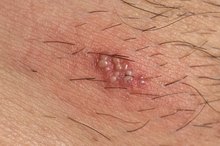Difference Between Hives & Shingles
Skin is your body’s largest organ and can be affected by a variety of ailments. Shingles and hives are both conditions which affect your skin; however, their similarities end there. These dermatological conditions have different causes, symptoms, duration and treatments.
If you are experiencing serious medical symptoms, seek emergency treatment immediately.
Causes
Hives, or urticaria, are itchy, swollen pink or red areas which are usually caused by an allergic reaction to medication, food or insect bites. Herpes zoster, or shingles, is caused by the same virus which causes chicken pox. The virus remains dormant within your nerve cells.
Symptoms
Acne & Shingles
Learn More
Symptoms of hives include welts of varying sizes which itch, burn or sting. Severe cases may cause swelling of the surrounding tissues. Shingles are characterized by burning, tingling pain or extreme sensitivity in a specific area of skin and a subsequent red, blistering rash which appears in the same area.
Duration
An acute case of hives will dissipate within 6 weeks (some cases disappear within a matter of days) while chronic urticaria lasts longer 1. Shingles usually clear up within a few weeks, although if treated with anti-viral medication early on, the duration may be shorter.
Treatment for Hives
Adrenal Fatigue & Hives
Learn More
The most effective treatment for hives is to identify and eliminate the underlying cause. Antihistamines may be helpful in alleviating some of the itching and severe cases may be treated with epinephrine or cortisone.
Shingles Treatment
Herpes zoster is usually treated with pain relievers and cool compresses to alleviate some of the painful symptoms. If taken within 72 hours of the virus’ onset, an anti-viral medication may be helpful.
Related Articles
References
- American Academy of Dermatology: Urticaria (Hives)
- Fine LM, Bernstein JA. Guideline of chronic urticaria beyond. Allergy Asthma Immunol Res. 2016;8(5):396–403. doi:10.4168/aair.2016.8.5.396
- Sachdeva S, Gupta V, Amin SS, Tahseen M. Chronic urticaria. Indian J Dermatol. 2011;56(6):622–628. doi:10.4103/0019-5154.91817
- American College of Asthma, Allergy, & Immunology. (2014). Types of Allergies: Hives (Urticaria).
- Casale TB. Omalizumab for Chronic Urticaria. J Allergy Clin Immunol Pract. 2014;1:118-9.
- Kahn DA. Alternative Agents in Refractory Chronic Urticaria: Evidence and Considerations on their Selection and Use. J Allergy Clin Immunol Pract. 2013;1:443-40.
Writer Bio
Caryn Anderson combines extensive behind-the-scenes writing experience with her passion for all things food, fashion, garden and travel. Bitten by the travel bug at the age of 15 after a trip to Europe, Anderson fostered her love of style and fashion while living in New York City and earning her degree at New York University.








